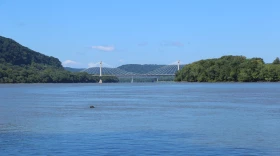
West Virginia is accepting bids on a plan to allow hydraulic fracturing for natural gas (or “fracking”) beneath the Ohio River. The move would provide the state with much-needed revenue, but environmental and citizen groups are concerned about the possible contamination of drinking water for millions of people.
Louisville is one of the communities downriver that uses the river for drinking water.
West Virginia and Ohio-based groups sent a letter to West Virginia Gov. Earl Ray Tomblin urging him to abandon the proposal.
We have significant concerns that regulations will not adequately safeguard our regional water supply. Will sufficient financial assurances be put in place to guarantee that funding will be available to replace all drinking water supplies along the Ohio River should a release occur? We believe the question is not “if” but “when” regarding earthquakes and potential spills and leaks of hydro fracking fluids and processed waste water whenever corporations are allowed to proceed with drilling under the river.
Tim Joice of the Kentucky Waterways Alliance said for the commonwealth, there are definitely concerns. But he said it would be premature to panic.
“When it comes to this specific situation, there’s an obvious concern, but it’s tempered by a kind of overall lack of sufficient research on understanding this situation: fracking under rivers,” he said.
Joice says if the drilling is viable, it should be done in a very limited scope, and studied to make sure no issues arise.
“So we essentially are doing a science experiment where we test it,” Joice said. “My concern is that West Virginia is going to say ‘OK, we’ve got two really big bids here, let’s go ahead and open this baby up and let’s get 20!’”
The proposals in West Virginia involve drilling a mile (5,280 feet) below the river bedrock. For contrast, the drilling that’s been going on in Louisville for the Ohio River Bridges Project will reach only 30 feet below the bedrock.
So far, West Virginia state officials haven’t updated the Ohio River Valley Water Sanitation Commission, or ORSANCO, on the plan. ORSANCO is the eight-state commission that sets the water quality standards for the Ohio River; the body is directly involved in planned water withdrawals from the river and direct discharges. But ORSANCO also gets involved in emergency situations, like the leak of chemical MCHM into a tributary of the river last January in Charleston, W.V.
ORSANCO Executive Director Peter Tennant said he’s not sure that fracking beneath the river poses a greater risk of water contamination than some of the other industrial activities happening on the Ohio.
“The safety record for the reputable drillers is decent,” he said. “I don’t know that we have to worry about anything from the drilling where it’s a mile below the river.”
Tennant said dealing with these activities is one of the challenges posed by a waterway that is used for so many industrial purposes, but is also a wildlife habitat and source of drinking water. Fracking waste could also soon be traveling down the Ohio via barge, if the Coast Guard approves a proposal.
Similarly, Kelley Dearing Smith, a spokeswoman for the Louisville Water Company, said the company’s scientists would approach any possible spill of fracking fluid like they do any other contamination.
"If there’s a new plant that’s coming upriver and we know there’s a potential for something to seep into the river or into the ground, then part of our wellhead protection program is we’re mapping travel time," she said.
Louisville Water routinely tests and monitors the water, and also relies on testing done upriver at other municipal water systems.
But there’s an additional challenge when dealing with fracking fluid: many of the chemicals used in the process are considered “trade secrets” and not disclosed. Drilling companies can report the chemicals used on websites like FracFocus, but that’s voluntary.
Tennant said ORSANCO is in discussions with gas drilling companies to make sure that information can be obtained if it’s needed. But right now, in the event of an accident, regulators would need to rely on receiving accurate information from drillers.
“But yeah, I mean, having the information beforehand helps the water utilities be prepared if there’s any special thing that they have to do, whether it’s additional treatment, whether it’s shutting their intake for awhile,” he said. “But the sooner they know about it and can plan for it, the better off everybody is.”
And as shown in January’s MCHM leak in West Virginia, industries can’t always be relied on to quickly and accurately report accidents.
Copyright 2014 89.3 WFPL News Louisville





